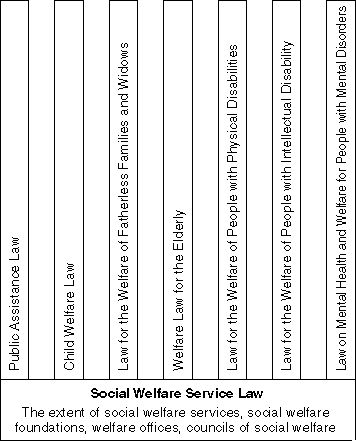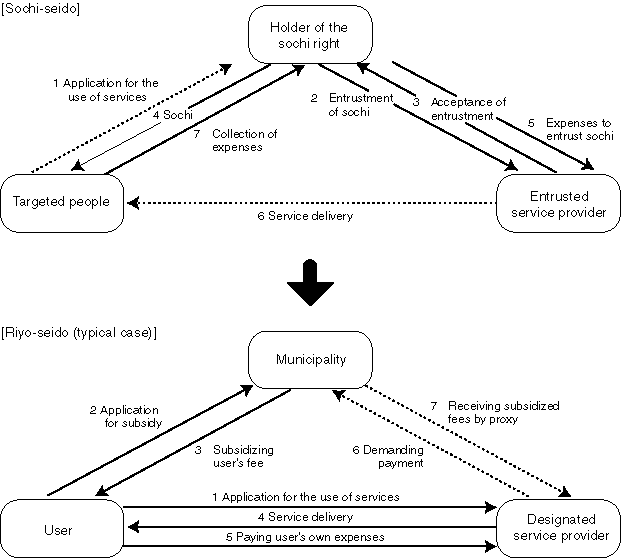
In order that welfare services will continue to be provided steadily and efficiently so that people can lead a safe life, it is necessary to strengthen and improve the above-mentioned basic structure of social welfare.
1. The Current Situation Surrounding Social Welfare Services
In the late 1940s, the Child Welfare Law was established in 1947 for the purpose of giving relief mainly to juvenile vagrants and war orphans, the Law for the Welfare of People with Physical Disabilities was established in 1949 with the aim of giving relief to people with physical disabilities whose number increased mainly due to the war, and the Public Assistance Law was established in 1950 for the purpose of giving relief to people who lost the ability to earn their own living and sank into poverty. Then, the Social Welfare Service Law was established in 1951 in order to provide the common foundations of social welfare including social welfare foundations, welfare offices, the Community Chest and the councils of social welfare. In addition, these welfare laws have prepared and improved the sochi-seido (the system that municipal governments judge the type and degree of disability for each people with disabilities and decide the content of service to be provided) and the sochi-hi (the expenses to support the sochi-seido).
Figure 4-1-1. The Outline of the Social Welfare Law System

In this way, the basic framework of Japan's postwar social welfare system was formed from the middle 1940s to the middle 1950s.
With the changing social structure, however, the environment surrounding social welfare has also largely changed. Since the standard of living largely improved after the high economic growth period, the number of the indigent decreased compared with the previous period. At the same time, as the numbers of nuclear families and salaried workers have increased, and as an increasing number of women have become working members of society these days, the ability of households to maintain family life has been weakening. This is also due to the change in people's awareness of family. As a result, what people expect of social welfare has shifted from the mere protection and relief of some people including the indigent, to the support for people as a whole for their independence. Thus, the demand for welfare services is steadily increasing and being diversified year by year.
2. The Necessity of the Basic Structural Reform of Social Welfare
Based on the above-mentioned situation, efforts have been made to deal with policy issues, which occurred in individual fields of social welfare. For example, in the field of welfare for elderly people, the Long-Term Care Insurance Law was established in 1997, and in the field of child welfare, the Child Welfare Law was revised in the same year.
However, the system of common foundations that support individual fields of social welfare has not changed its basic framework for half a century since its establishment. As a result, there are various aspects, which are out of step with the demands of the times. For example, regarding social welfare foundations, which are major providers of welfare services, it is pointed out that they have structural problems that prevent them from operating properly and efficiently, partly due to their scandals. In addition, the system called sochi-seido, which was formed under the special demands of the times after the war and has supported the development of social welfare in Japan, shows a sign of institutional fatigue. This system has an advantage that the government can allocate limited social resources in accordance with the order of priority by means of administrative measures. On the other hand, since the government entrusts service providers including social welfare foundations with sochi (the provision of welfare services), services are not chosen based on the intention of users. And since there are no definite relations of rights and duties between service users and providers, there is a shortage of the user-oriented viewpoint, and the efficiency and quality of the service provision is not necessarily improved.
These days, when the society has matured, and the social welfare system is expected to play the role of a safety net for all the people, people's demand for welfare services is likely to increase and become diversified in the future. In order to comply with people's expectations of the social welfare system and to further improve welfare measures from the user-oriented viewpoint, it is indispensable to thoroughly review and strengthen the system of common foundations for social welfare.
3. The Direction of the Basic Structural Reform of Social Welfare
(1) Report from the Study Group on the Ideal Social Welfare Service
The Ministry of Health and Welfare held a meeting of the "Study Group on the Ideal Social Welfare Service" which consisted of well-learned persons and experts in August 1997 and proceeded with broad discussions concerning the basic structure of social welfare. As a result, the Study Group prepared a report entitled "The Basic Structural Reform of Social Welfare (Major Disputed Points)." This report shows the six courses of reform, such as the establishment of the equal relations between service providers and users, general support to comply with individuals' various demands, the achievement of the service quality and efficiency that can obtain people's trust and assent and the promotion of a participation by various players. As matters to be further considered in order to realize these courses, several disputed points including the social welfare service, sochi-seido, the preparation and improvement of facilities and social welfare foundations are listed.
(2) "The Basic Structural Reform of Social Welfare (Interim Report)"
Referring to the major disputed points which were presented by the Study Group, animated discussions began to be made at the Subcommittee on the Structural Reform of Social Welfare which was established at the Central Social Welfare Council in November, 1997, and on June 17, 1998, an interim report "The Basic Structural Reform of Social Welfare" was released.
In the item 2) Achievement of the high-quality and efficiency of welfare services, the following is highlighted.
In the item 3) Establishment of regional welfare, the following measure is suggested.
(3) Discussions at the Ministry of Health and Welfare and "In Promoting the Basic Structural Reform of Social Welfare (Additional Opinions)"
After the interim report was released, the Ministry of Health and Welfare exchanged views with more than thirty related organizations and held symposiums in six places throughout the nation to exchange opinions. Through these opportunities, the Ministry heard a wide range of opinions concerning the items pointed out in the interim report and considered them.
The content of this consideration was reported to the Subcommittee on the Structural Reform of Social Welfare. Based on the report, the Subcommittee prepared the report "In Promoting the Basic Structural Reform of Social Welfare (Additional Opinions)" on December 8, 1998.
The Additional Opinions emphasize that it is necessary to reform and strengthen the basic structure of social welfare and to indicate several points to be paid attention in consideration in accordance with the Ministry of Health and Welfare's report on the content of consideration. The Additional Opinions also points out that efforts to revise the Social Welfare Service Law should be made while listening to plenty of opinions from the related councils.
In addition, regarding the concern that this structural reform may lead to the retrogression of public responsibility, the Additional Opinions mention that this reform is designed to restructure the welfare system from the viewpoint of users, on the assumption that the central and local governments are responsible for promoting social welfare. The Additional Opinions also show the following two points to which the Ministry of Health and Welfare should pay attention: 1 To promote considerations while sufficiently informing the purpose of this reform to the parties concerned and 2 In promoting reforms, to give sufficient considerations so that local governments which actually implement welfare services will not have difficulty in properly maintaining the implementation system as well as securing financial resources.
In response to these suggestions, the Ministry of Health and Welfare is making preparations to submit proposed revisions of the related laws including the Social Welfare Service Law to the Diet in order to continue to promote the structural reform.
This reform also includes many areas in which current operations should be reviewed, and therefore, in parallel with the revision of the laws, reforms in terms of operation are also considered. Regarding ideal systems for protecting the rights in the field of social welfare, the review of the curricula for fostering social welfare experts including certified social workers, and the maintenance and improvement of the quality of welfare services, the Ministry held meetings of the study group consisting of well-learned people and experts to discuss them.
Among them, regarding the system for protecting the rights in the field of social welfare, while taking into consideration the implementation of the Public Long-Term Care Insurance System, the "Project to protect the rights in regional welfare" will be conducted mainly by the prefectural councils of social welfare throughout the country in October 1999. This project is supposed to complement the System of Guardianship of Legal Majority and to give daily-life support, such as facilitating the use of proper welfare services.
Table 4-1-2. "The Whole Image of the Basic Structural Reform of Social Welfare"
(1) Establishment of a User-Oriented Social Welfare System
|
4. Re-Inspecting Facility Development Projects
At the end of 1996, there was a scandal that the social welfare facility development system for social welfare foundations including special nursing homes for the elderly was abused. With this scandal, the Ministry of Health and Welfare established the "Investigating Committee to Re-Inspect Facilities Development Projects" within the Ministry in December 1996, in order to clarify the truth about the scandal, to review the procedure for deciding subsidies for facility maintenance and development, and to promote proper service operation concerning the authorization and management of social welfare foundations.
On March 31, 1997, the Investigating Committee published a report. In the report, the following are listed as improvement measures concerning the development of social welfare institutions including special nursing homes for the elderly: 1 To clarify the method of deciding facilities to which subsidies are provided; 2 To enter into proper contracts of construction works in accordance with those for public works; 3 To ensure fair operation of social welfare foundations with the participation of various kinds of human resources; 4 To improve inspections and examinations; and 5 To ensure proper operation of the designated donation system of the community chest societies. In addition, the report generally shows the results of consideration concerning the improvement measures concerning the development of facilities in other fields such as medical facilities, the public water supply and waste disposal facilities, national hospitals, social health service facilities, as well as the ideal system of personnel affairs for temporary transfer. In preparing the report, the Investigating Committee suggests that so that each staff of the Ministry of Health and Welfare will continue to make constant efforts to properly conduct their duties in the future, March 31 every year will be decided as the "Ministry of Health and Welfare's Self-Examination Day" to reexamine the progress of the items to be improved which are mentioned in the report.
Based on these principles, on the Ministry of Health and Welfare's Self-Examination Day on March 31, 1999, measures which were taken within the fiscal 1998 were summed up in the same way as the previous year, in order to examine the progress of the items to be improved based on the Investigating Committee's report.
Figure 4-1-3. Conceptual Chart of Systematizing the Use of Welfare Services
